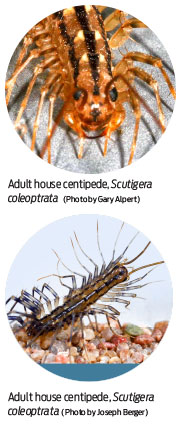 Editor’s note: Levi Brody, A.C.E. and co-owner of Brody Brothers, Owings Mills, Md., shared his knowledge of, and experience with, centipedes in the following article.
Editor’s note: Levi Brody, A.C.E. and co-owner of Brody Brothers, Owings Mills, Md., shared his knowledge of, and experience with, centipedes in the following article.
House centipedes are believed to have originated from the Mediterranean area. These pests do not tolerate temperate regions and can only survive indoors during cold weather. Known for being nocturnal and predacious, house centipedes prefer smaller arthropods to feed on such as carpet beetle larvae, silverfish, and spiders. You can find house centipedes hiding out in the damp parts of your home, such as the crawl space and basement.
Common Service Mistakes with House Centipedes:
● Not Performing a Thorough Inspection First:
✔ First Rule of Integrated Pest Management: INSPECTION. By conducting a thorough inspection of the home, you will be able to determine which arthropods the House Centipedes are feeding on (like silverfish and spiders), and where in the structure they are doing so. This will allow you to identify what hot spots should be the focus of your treatment.
** Most House Centipede callbacks that I have dealt with seem to have active spiders, both indoors and outdoors. Make sure these issues are properly addressed during your initial service to the home.
● Treatment on the Interior:
✔ Spraying baseboards should not be considered a complete treatment for House Centipedes. We must take the fight to them!
** First, we tackle the indoors. Some of the most common areas include seams and expansion joints, slabs, dimple/water board voids, sump-pump area(s) and the sill plate/band board junction. These areas can be treated with a microencapsulated product or a dust, such as my go-to product: Apomorphic Silica.
** Other areas include cracks and seams in hollow-block foundation walls, uncapped areas of hollow block (often near crawl space vents), and gaps in the window trim. We all know from inspections for bedbugs, the bottom edge of the window trim is often not properly caulked, leaving a nice gap for pests to hide inside. This can be easily solved by sealing this gap!
● Treatment of the Exterior:
✔ Even though House Centipedes have no problem living their entire lifecycle indoors, it is very common for them to have outdoor populations in warmer weather as well.
** At minimum, the seams, along with cracks and crevices around the foundation of a home, should be treated. Make sure you include those expansion joints where sidewalks or driveways meet the home.
** A go-to treatment spot of mine is the seams in retaining walls. This area can be addressed by pin-treating with a microencapsulated product or dust straight into those voids.
● Continue to Monitor:
✔ House Centipedes often need to cover some major ground to stay well-fed in modern homes. Pest monitors can be a tremendous help with reducing indoor numbers and helping locate focus points around the house!
** Placing one pest monitor in a 2,500-square foot home won’t do it! Make sure you use two to four pest monitors per suspected room(s). This should be standard. Remember, you can always remove non-performing pest monitors on your next visit. In this case, the more the merrier!
● Customer Cooperation:
✔ We pride ourselves on being straight-forward. Before we start giving corrective actions to our clients, we encourage them to ask themselves, “Should I have my entire crawl space encapsulated because my spouse spotted five House Centipedes inside?”
** Always start and focus on the most practical corrective actions first, such as cleaning leaves out of the ol’ window well or removing clutter or boxes in damp parts of the basement. I may write a report and note the other solutions, like installing vapor barriers in crawl spaces, but my focus is on one solution and the most practical solution at a time.

